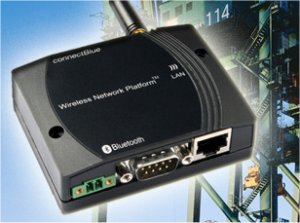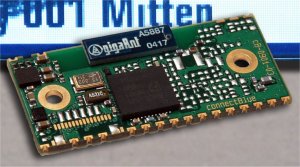Bluetooth link replaces Ethernet cables
The Swedish industrial communications specialist connectBlue has introduced what it claims is the world’s best-performing compact wireless network platform for industrial use. The platform provides robust, reliable Bluetooth connections between Ethernet-based infrastructures and industrial equipment such as PLCs, mobile HMIs, machines, barcode readers, and sensors.

The platform (above) is designed to act as a universal Ethernet-to-Bluetooth link with a wide variety of potential applications, configured easily via customised Web pages. It can replace Ethernet cables to provide wireless communications for moving and rotating devices, or can be applied where cables would be difficult or expensive to install.
The platform supports up to seven Bluetooth serial port connections to an Ethernet network. A terminal server function provides "virtual serial cables" between industrial devices and Ethernet-connected PCs.
"The Wireless Network Platform does not just simplify and reduce the actual installation costs, it also provides a completely maintenance-free connection," says connectBlue president, Rolf Nilsson. "And, although the product itself is new, the underlying platform is a proven solution that has been in years of operation 24/7 under rough industrial conditions. This is why we can vouch for the Wireless Network Platform being the smallest, high-performing industrial Bluetooth access point available on the market."
In another development, connectBlue has announced a Bluetooth-based adaptor that, it says, offers an easy, low-cost way of connecting devices such as sensors, signal converters and displays, wirelessly.

The I²C (Inter-Integrated Circuit) adapter, aimed at OEMs, is a multi-master serial computer bus that can link devices to, for example, an embedded system. By connecting the adapter (shown above) to an I²C bus, the user does not need to connect an I²C master device directly to bus. Instead, the adapter implements the master side of the bus interface and, using Bluetooth, makes it possible to enable several slaves on an I²C bus wirelessly. The "original" master device can then access all slaves available on the I²C bus via Bluetooth.
"The advantage of a bus connection is how it can connect multiple devices logically over the same set of wires," explains Nilsson. "Via our new Bluetooth I²C Bus Adapter, it can now make this connection wirelessly. Thus, when you connect mobile or temporary devices, or when you want to overcome complicated and costly installations of displays and sensors, the Bluetooth I²C Bus Adapter provides an efficient and easy-to-use solution."





